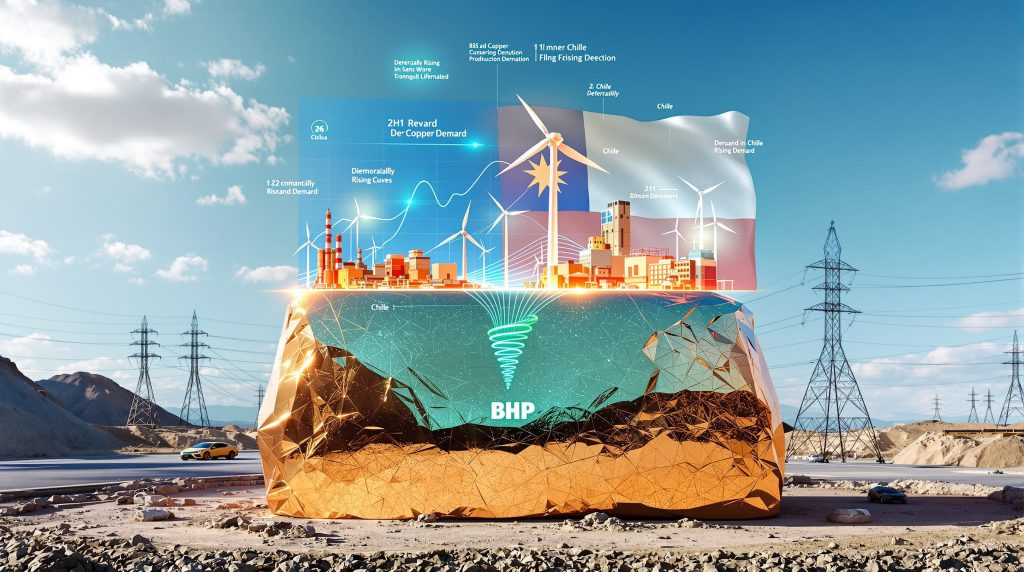BHP's Strategic Copper Focus: Navigating High-Demand Markets
BHP Group has strategically positioned itself as the world's largest copper producer, capitalizing on growing global demand for this essential metal. This pivotal shift represents a fundamental transformation in BHP's BHP copper outlook, with copper now contributing a remarkable 45% of the company's total underlying EBITDA—a significant increase from 29% just one year ago.
The mining giant achieved record copper production of 2 million tonnes in FY25, marking an 8% year-over-year increase. This production milestone represents a 28% increase since FY22, highlighting BHP's aggressive expansion through both organic growth and strategic acquisitions.
The Financial Impact of BHP's Copper Strategy
BHP's copper division delivered exceptional financial performance in FY25, generating a record US$12.3 billion in EBITDA—a 44% increase compared to FY24. This impressive growth occurred despite broader market challenges, underscoring the resilience of BHP's copper operations.
The company's copper assets achieved EBITDA margins of 59%, demonstrating their inherent profitability and operational efficiency. BHP realized an average copper price of US$4.25 per pound in FY25, representing a 7% increase from the previous year and contributing to the strong financial performance.
This copper-driven financial success has provided BHP with substantial cash flow to reinvest in further expansion while maintaining its commitment to shareholder returns. The company allocated US$4.5 billion to copper development in FY25 alone, representing nearly half of its total US$9.8 billion capital expenditure for the year.
Global Copper Demand Outlook
Projected Consumption Growth
BHP projects global copper demand to grow dramatically from approximately 33 million tonnes (Mt) today to more than 50 Mt by 2050—a 50% increase that will require significant new production capacity. This forecast is driven by several interconnected trends reshaping the global economy:
-
Renewable Energy Expansion: Solar and wind installations require substantial copper for electrical components and transmission infrastructure.
-
Electric Vehicle Growth: Each EV uses significantly more copper than conventional vehicles, with requirements ranging from 40kg to 83kg per vehicle compared to 15kg in traditional cars.
-
Grid Infrastructure Development: Upgrading and expanding electricity networks to support renewable integration requires massive copper inputs.
-
Data Center Proliferation: Digital infrastructure expansion is creating new copper demand streams, with modern data centers requiring extensive copper wiring.
-
Urbanization in Developing Economies: Continued infrastructure development in emerging markets drives significant copper consumption.
BHP estimates that copper demand from data centers alone could increase sixfold to 3 Mt annually by 2050—equivalent to the combined output of the world's four largest copper mines. This represents just one segment of the broader electrification trend driving surging copper demand.
Regional Demand Patterns
China remains the dominant consumer of copper globally, demonstrating resilient demand despite property sector challenges. Chinese copper consumption increased by 8% in the most recent calendar year, reflecting continued industrial strength and investment in copper-intensive infrastructure.
India is emerging as another critical growth market, with BHP's leadership describing it as "one of the most exciting countries in terms of growth." As India develops into the world's third-largest economy, its infrastructure needs and manufacturing ambitions will drive substantial copper demand growth.
Copper Supply Challenges
The Growing Supply-Demand Gap
The global copper industry faces significant structural challenges in meeting projected demand growth. Industry analysts warn of a potential supply deficit reaching 10 million tonnes by 2035—a gap that would require approximately $250 billion in new investment to address.
Several factors contribute to this looming supply shortfall:
-
Declining Ore Grades: Average copper grades have fallen by 40% since 1991, requiring more material to be processed for the same copper output.
-
Extended Development Timelines: New copper mines typically require 7-10 years from discovery to production, creating a lag between investment decisions and new supply.
-
Rising Capital Intensity: New projects face increasing costs due to deeper deposits, remote locations, and complex metallurgy.
-
Permitting Challenges: Regulatory hurdles and community concerns are extending development timelines beyond historical norms.
-
Resource Nationalism: Growing government intervention in major copper-producing regions adds uncertainty to investment decisions.
The International Energy Agency forecasts that under current policies, the world could face a 30% copper supply deficit by 2035. This gap widens to 35% under announced climate pledges and exceeds 40% under net-zero emissions scenarios—highlighting how accelerated decarbonization increases copper demand pressures.
BHP's Short-Term Market Outlook
For FY26, BHP maintains that the global copper market will be "broadly balanced." The company notes that mine supply has faced challenges in recent months, with growth expectations downgraded in several regions. Trade barriers affecting copper scrap movement may further increase demand for primary copper.
BHP expects to produce between 1,800 and 2,000 kilotonnes of copper on a consolidated basis in FY26, essentially maintaining current production levels. However, the company anticipates that new, uncommitted mine supply will be required by the late 2020s as demand continues to grow and existing production peaks.
BHP's Copper Portfolio Expansion
Strategic Acquisitions and Joint Ventures
BHP has aggressively expanded its copper portfolio through strategic acquisitions and joint ventures. The company completed a significant acquisition of Oz Minerals in 2023, adding the Prominent Hill and Carrapateena mines in South Australia to its asset base and strengthening its position in a stable mining jurisdiction.
In FY25, BHP invested US$2.1 billion to acquire a 50% interest in the Vicuña copper project in Argentina, which includes the Josemaria deposit and the Argentina copper system at Filo del Sol—described as one of the largest greenfield copper discoveries in 30 years. Through its Vicuña joint venture with Lundin Mining, BHP expects to bring two copper projects in Argentina into production by 2030.
These strategic moves have secured what BHP claims is the world's largest copper resource base, providing substantial optionality to meet projected supply shortfalls in the coming decades.
Chilean Operations Expansion
BHP plans significant investments in its Chilean operations, where it operates the world's largest copper mine, Escondida. The company has committed between US$10.7 billion and US$14.7 billion over the next decade to address declining ore grades and extend the productive life of its major copper assets in the region.
At Escondida, BHP plans to invest between US$7.3 billion and US$9.8 billion in new projects beginning in 2028. These initiatives include:
-
Construction of a new concentrator expected to produce 220,000-260,000 tonnes annually from 2031-2032 (US$4.4-5.9 billion investment)
-
Expansion at Laguna Seca within the Escondida complex to boost production by 50,000-70,000 tonnes annually from 2030-2031 (US$2-2.6 billion investment)
These projects aim to stabilize Escondida's production at approximately 1.4 million tonnes annually, ensuring continued operation of this world-class asset for decades to come.
South Australian Growth Potential
In South Australia, BHP is working to deliver up to 650,000 tonnes per annum of copper from its 100%-owned Copper SA business. This expansion leverages the company's existing infrastructure and operational expertise in the region, while benefiting from Australia's stable regulatory environment.
The integration of Oz Minerals' assets has strengthened BHP's position in the Olympic Dam region, creating operational synergies and exploration opportunities. BHP's South Australian copper operations benefit from proximity to established infrastructure and access to skilled labor, reducing development risks compared to more remote or politically challenging jurisdictions.
BHP's Long-Term Copper Strategy
Production Growth Targets
BHP has outlined ambitious growth plans for its copper business, with several projects in execution and under study that could deliver approximately 2 million tonnes per annum of new attributable copper production in the 2030s—effectively doubling the company's current production.
The company's growth program at Escondida is expected to generate an additional 400,000 tonnes of cumulative copper production incrementally over FY27 to FY31, weighted toward the later years of this period. This growth will help offset natural production declines at aging operations while positioning BHP to capture value from rising copper prices.
Technological Innovation
BHP's expansion strategy incorporates significant investments in technology and operational innovation to improve efficiency, reduce environmental impact, and enhance worker safety. The company has implemented advanced ore sorting technology, optimized concentrator throughput, enhanced water management systems, and precision blasting techniques that reduce dilution at its major operations.
These technological improvements have contributed to production increases at existing facilities while positioning BHP to extract value from lower-grade ore bodies that might not be economical for less technologically advanced operators.
Capital Allocation Strategy
BHP has committed to investing approximately 70% of its medium-term capital expenditure in copper and potash projects, demonstrating a clear strategic prioritization of these commodities over traditional iron ore and coal operations. This investment framework encompasses organic expansion at existing operations, strategic acquisitions, and joint ventures to access promising development opportunities.
The company's capital allocation strategy reflects its confidence in copper's long-term fundamentals and its assessment that copper assets will generate superior returns compared to other commodities in its portfolio. BHP's financial strength allows it to pursue counter-cyclical acquisition strategies, acquiring assets during market downturns when valuations are more attractive.
Challenges in BHP's Copper Strategy
Operational Challenges
Despite BHP's strong position in the copper market, the company faces several operational challenges:
-
Declining Ore Grades: Like the broader industry, BHP must contend with gradually declining ore grades at its mature operations, requiring increased processing volumes to maintain production levels.
-
Water Management: Many copper operations are located in water-stressed regions, necessitating significant investments in water conservation and alternative supply sources.
-
Energy Costs: Copper production is energy-intensive, and rising energy prices can impact operational costs, particularly for grinding and concentration processes.
-
Labor Relations: Maintaining positive relationships with workforces across diverse jurisdictions presents ongoing management challenges for BHP's global operations.
BHP's operational excellence and technical expertise provide advantages in addressing these challenges, but they nonetheless require continuous attention and investment to mitigate their impact on production and costs.
Political and Regulatory Risks
BHP's copper operations span multiple jurisdictions, exposing the company to varying degrees of political and regulatory risk:
-
Chilean Political Environment: Changes to mining taxation and environmental regulations in Chile could impact the economics of BHP's largest copper operations.
-
Resource Nationalism: Growing government intervention in resource sectors globally may affect future development opportunities, particularly in Latin America.
-
Permitting Timelines: Increasingly complex regulatory processes are extending development timelines for new projects beyond historical norms.
-
Community Relations: Growing expectations for community benefits and environmental protection are affecting social license to operate across BHP's portfolio.
BHP's diversified geographical footprint provides some mitigation against country-specific risks, but the company must navigate an increasingly complex stakeholder environment to execute its copper growth strategy successfully.
Copper's Role in BHP's Portfolio Strategy
Commodity Diversification Benefits
BHP's increasing focus on copper represents a strategic diversification away from its traditional reliance on iron ore, which has historically dominated the company's earnings profile. This diversification provides several benefits:
-
Reduced Earnings Volatility: Copper prices often move independently from iron ore, providing portfolio stabilization and reducing overall earnings volatility.
-
Exposure to Different Economic Drivers: While iron ore demand is heavily tied to steel production and construction, copper demand is increasingly linked to electrification and renewable energy.
-
Geographic Diversification: BHP's copper assets span multiple continents, reducing exposure to regional economic or political disruptions.
-
Future Growth Potential: Copper offers stronger long-term demand growth prospects than many traditional mining commodities due to its critical role in the energy transition.
This strategic rebalancing positions BHP to benefit from both traditional infrastructure development in emerging economies and the global transition to renewable energy and electrification.
Alignment with Decarbonization Trends
BHP's copper strategy aligns with broader global decarbonization efforts, positioning the company to benefit from the transition to a lower-carbon economy. The company has publicly recognized that copper is essential to creating the infrastructure needed for renewable energy sources, such as wind and solar.
This strategic alignment enhances BHP's environmental, social, and governance (ESG) credentials while simultaneously targeting a commodity with strong growth fundamentals. The company's copper focus allows it to maintain its mining expertise and operational capabilities while shifting toward metals that support rather than impede climate goals.
Market Outlook for FY26
For the immediate future, BHP maintains that the global copper market will be "broadly balanced" in FY26. The company notes that mine supply has faced challenges in recent months, with growth expectations downgraded in several regions. Trade barriers affecting copper scrap movement may further increase demand for primary copper supply.
BHP expects to produce between 1,800 and 2,000 kilotonnes of copper on a consolidated basis in FY26, essentially maintaining current production levels. The company anticipates that new, uncommitted mine supply will be required by the late 2020s as demand continues to grow and existing production peaks.
In Peru, BHP expects its Antamina operation to produce between 120 and 140 kilotonnes in FY26. The company holds a 33.75% stake in this operation, which continues to deliver strong operational performance.
BHP's Copper Transformation
BHP's strategic pivot toward copper represents a fundamental transformation of its business model and long-term growth strategy. The company has successfully positioned itself as the world's largest copper producer at a time when the metal's importance to the global economy is growing dramatically.
This transformation has already delivered significant financial benefits, with copper now contributing 45% of BHP's total underlying EBITDA. The company's ambitious growth plans could double its copper production in the 2030s, further strengthening its position in this critical market.
While challenges remain—including declining ore grades, rising capital intensity, and complex regulatory environments—BHP's financial strength, technical expertise, and diversified asset base position it well to navigate these obstacles and capitalize on copper's strong long-term fundamentals.
For investors looking at various copper investment strategies, the company's copper strategy offers exposure to one of the most compelling commodity growth stories of the coming decades. As the world transitions toward renewable energy and electrification, copper price insights suggest demand is projected to grow dramatically, potentially creating sustained price strength that would benefit established producers like BHP with high-quality assets and expansion capabilities.
FAQ: BHP's Copper Strategy
How much copper does BHP currently produce?
BHP produced a record 2 million tonnes of copper in FY25, representing an 8% increase compared to FY24 and a 28% increase since FY22.
What percentage of BHP's earnings comes from copper?
Copper contributed 45% of BHP's total underlying EBITDA in FY25, up significantly from 29% in FY24.
What is BHP's projection for global copper demand?
BHP projects global copper demand to grow from approximately 33 million tonnes today to more than 50 million tonnes by 2050.
What are BHP's major copper assets?
BHP's copper portfolio includes the Escondida mine in Chile (the world's largest copper mine), Olympic Dam in Australia, Antamina in Peru, and recently acquired assets from Oz Minerals in Australia.
How much is BHP investing in copper expansion?
BHP allocated US$4.5 billion to copper development in FY25 alone, representing nearly half of its total US$9.8 billion capital expenditure for the year.
What is driving increased copper demand?
The primary drivers include renewable energy infrastructure, electric vehicle production, electricity grid expansion, data center growth, and continued urbanization in developing economies.
What challenges does the copper industry face in meeting future demand?
Key challenges include declining ore grades, extended development timelines for new mines, rising capital intensity, permitting difficulties, and growing resource nationalism in producing countries. According to the global copper supply forecast, these challenges will create significant supply-demand imbalances in the coming years.
Looking to Invest in Copper Opportunities?
Stay ahead of the market with Discovery Alert's proprietary Discovery IQ model, which delivers real-time notifications on significant ASX mineral discoveries, including copper opportunities. Visit our discoveries page to understand how major mineral discoveries can lead to exceptional investment returns.




